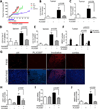CSF1R signaling blockade stanches tumor-infiltrating myeloid cells and improves the efficacy of radiotherapy in prostate cancer
- PMID: 23418320
- PMCID: PMC4097014
- DOI: 10.1158/0008-5472.CAN-12-3981
CSF1R signaling blockade stanches tumor-infiltrating myeloid cells and improves the efficacy of radiotherapy in prostate cancer
Abstract
Radiotherapy is used to treat many types of cancer, but many treated patients relapse with local tumor recurrence. Tumor-infiltrating myeloid cells (TIM), including CD11b (ITGAM)(+)F4/80 (EMR1)+ tumor-associated macrophages (TAM), and CD11b(+)Gr-1 (LY6G)+ myeloid-derived suppressor cells (MDSC), respond to cancer-related stresses and play critical roles in promoting tumor angiogenesis, tissue remodeling, and immunosuppression. In this report, we used a prostate cancer model to investigate the effects of irradiation on TAMs and MDSCs in tumor-bearing animals. Unexpectedly, when primary tumor sites were irradiated, we observed a systemic increase of MDSCs in spleen, lung, lymph nodes, and peripheral blood. Cytokine analysis showed that the macrophage colony-stimulating factor CSF1 increased by two-fold in irradiated tumors. Enhanced macrophage migration induced by conditioned media from irradiated tumor cells was completely blocked by a selective inhibitor of CSF1R. These findings were confirmed in patients with prostate cancer, where serum levels of CSF1 increased after radiotherapy. Mechanistic investigations revealed the recruitment of the DNA damage-induced kinase ABL1 into cell nuclei where it bound the CSF1 gene promoter and enhanced CSF1 gene transcription. When added to radiotherapy, a selective inhibitor of CSF1R suppressed tumor growth more effectively than irradiation alone. Our results highlight the importance of CSF1/CSF1R signaling in the recruitment of TIMs that can limit the efficacy of radiotherapy. Furthermore, they suggest that CSF1 inhibitors should be evaluated in clinical trials in combination with radiotherapy as a strategy to improve outcomes.
Figures







Comment in
-
Re: CSF1R signaling blockade stanches tumor-infiltrating myeloid cells and improves the efficacy of radiotherapy in prostate cancer.J Urol. 2014 Jan;191(1):270-1. doi: 10.1016/j.juro.2013.10.007. Epub 2013 Oct 7. J Urol. 2014. PMID: 24331512 No abstract available.
References
-
- Delaney G, Jacob S, Featherstone C, Barton M. The role of radiotherapy in cancer treatment: estimating optimal utilization from a review of evidence-based clinical guidelines. Cancer. 2005;104(6):1129–1137. Epub 2005/08/05. PubMed PMID:16080176. - PubMed
-
- Agarwal PK, Sadetsky N, Konety BR, Resnick MI, Carroll PR. Treatment failure after primary and salvage therapy for prostate cancer: likelihood, patterns of care, and outcomes. Cancer. 2008;112(2):307–314. Epub 2007/12/01. PubMed PMID:18050294. - PubMed
-
- D'Amico AV, Renshaw AA, Sussman B, Chen MH. Pretreatment PSA velocity and risk of death from prostate cancer following external beam radiation therapy. Jama. 2005;294(4):440–447. Epub 2005/07/28. PubMed PMID:16046650. - PubMed
-
- Bianco FJ, Jr, Scardino PT, Stephenson AJ, Diblasio CJ, Fearn PA, Eastham JA. Long-term oncologic results of salvage radical prostatectomy for locally recurrent prostate cancer after radiotherapy. Int J Radiat Oncol Biol Phys. 2005;62(2):448–453. Epub 2005/05/14. PubMed PMID:15890586. - PubMed
Publication types
MeSH terms
Substances
Grants and funding
LinkOut - more resources
Full Text Sources
Other Literature Sources
Medical
Research Materials
Miscellaneous

